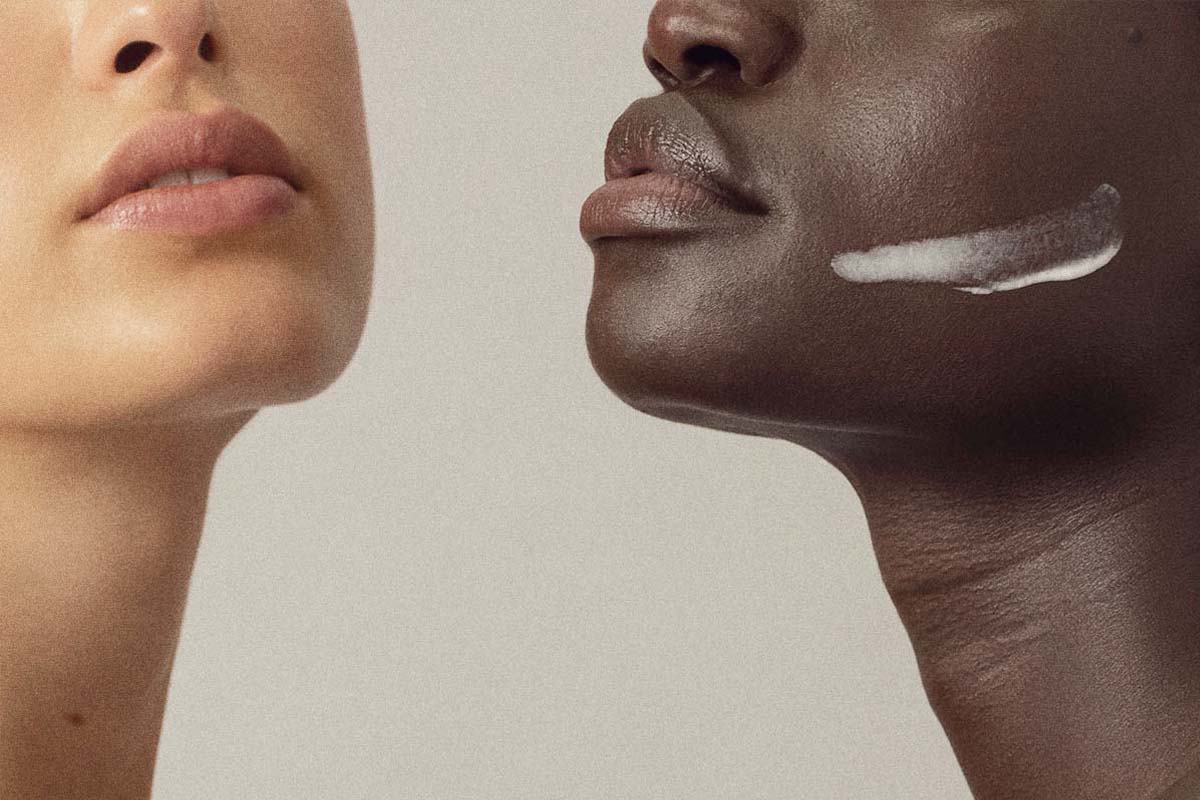Hardly any other buzzword currently defines the beauty industry more than this: “clean.”
It doesn't matter whether you browse the shelves of drugstores, your favorite online shop, or your Insta feed - you will encounter clean cosmetics and clean brands everywhere. But is clean beauty more of a short-term trend or the new standard? And how clean is This Place as a label for functional natural cosmetics?
In this article, This Place takes you on a scrutinizing look at the meaning behind clean beauty. Here we explain the following clean beauty aspects:
- What is clean beauty?
- How do you recognize clean beauty products or clean beauty brands?
- Why is This Place a clean brand?
- Wrap up: Clean cosmetic products are changing the cosmetics market
- FAQ
What is clean beauty?
We hear these words everywhere, but what does it mean? Clean beauty is about knowing what’s going onto your skin and where the ingredients in your products come from. You might be thinking: "Aha, so clean, pure cosmetics." So far, so good. But, what exactly does “clean” or “pure” mean in this context? When we use the term clean, we mean that a product is safe, non-toxic, and has transparent labeling of ingredients. These are products that include ethically sourced ingredients made with our bodies' health and the environment in mind.
As mentioned earlier, clean beauty is one of the current buzzwords in the cosmetics industry worldwide. Two years after clean beauty began its triumphant march across the Atlantic to Germany, we can answer this question both from the customer's point of view and from the point of view of each brand that offers clean products.
How do you recognize clean beauty products or clean beauty brands?
In principle, brands, suppliers, and customers agree that clean beauty includes a range without controversial, possibly harmful ingredients, in terms of sustainability and the environment, and when it comes to your (skin) health. Often the reference to animal-testing-free cosmetics resonates.
The phenomenon of clean beauty products owes its success to people like you: people who want to know what their skin comes into contact with; people interested in the ingredients list of products and not just the packaging text; and people who want to make conscious purchasing decisions.
However, what exactly is controversial or harmful and therefore “taboo” ingredients is something each brand defines for themselves because there have been no binding, uniform standard or a generally applicable definition.
In 2019, the International Cosmetics Association (ICADA) developed the world's first standard for clean beauty and clean products based on a blacklist of several thousand ingredients [1]. However, it is not mandatory to apply for this label to use the designation “clean.” So the claim to be a clean beauty product can be attributed more to the marketing team than to those responsible for formulating a product.
It’s important to avoid equating clean beauty with “natural cosmetics” or “purely natural ingredients.” For consumers, clean is also no guarantee that it does not contain any ingredients that could cause a reaction, such as known allergies or susceptible skin.
Although you won't have access to a definitive overview in your search for clean beauty products and brands, having a few of the essential ingredients in mind can provide you with some guidance.
Whether and for what reasons you, as a responsible consumer, want to avoid products with these ingredients is your personal preference.
Individual chemical UV filters
There is no doubt that sun protection makes sense at any time of the year, regardless of how much sunlight you feel.
But it is suspected that chemical filters such as oxybenzone or benzophenone-3 can influence your hormone balance or trigger allergies [2]. In addition, they cannot be degraded by nature. Thus, bathing in the sea or lake can pollute the water and, therefore, the basis of life for numerous animals and plants.
Petroleum/Petroleum Products and Silicones
In contrast to natural ingredients, mineral oil and silicones are usually significantly cheaper. Also, they don't react with your skin. That is why they are the ingredient of choice when high skin tolerance is crucial, for example, in creams used as medicines. You can recognize them by the designations “Paraffinum liquidum,” “Dimethicone,” “Dimethiconol,” or “Methicone”.
If what matters most to you is how your facial skin feels beneath your scrutinizing fingertips, then these ingredients offer a consistently enjoyable experience. Because they form a velvety soft, supple film on the surface, which makes your skin feel very smooth and tender. In the long term, however, they offer no inherent care benefit for healthy skin. On the contrary.
Every time you clean your face with water or remove makeup, these ingredients end up in the wastewater - and shortly afterward, in the worst case, in nature.
These ingredients can also trigger the so-called “pilling effect” or play a role in “skin purging.”
PEG
The abbreviation PEG stands for polyethylene glycol, a consistency enhancer for creams. PEG is obtained from petroleum and is ecologically questionable because it can hardly be broken down. In addition, PEG is suspected of weakening your natural skin barrier and thus making it permeable to unwanted substances.
Parabens
Parabens are used as preservatives in care products and decorative cosmetics. However, hormone-like effects on the body have been observed, throwing your body's natural hormone balance out of balance.
Sulfates
Sulfates ensure a full foam in individual products, for example washing gels or shower gels. However, due to their cleansing effect, sulfates can (destroy) the lipid film of your skin, which can cause your skin to lose moisture, among other things.
Animal testing, seals, sustainability & prices
In addition to the designation as clean beauty, numerous manufacturers often point out that they are cruelty-free, i.e., they do not test on animals to manufacture their products. You can recognize this, for example, by the bunny from the bunny seal.
Individual brands and manufacturers also rely on seals to signal to you as a consumer that it is clean beauty. However, it should be emphasized again that there is no single uniform seal for this market, similar to organic or natural cosmetics. For you, a seal is the first clue. However, it does not mean that your understanding of clean beauty is 100% fulfilled.
By the way, you don't recognize clean beauty products from the price alone. The ingredients used, brand name, and brand positioning are decisive.
Numerous clean beauty brands combine clean formulations with the claim to use sustainable packaging or avoid ingredients that can harm the environment, either because they are difficult to degrade or because their extraction pollutes the environment.

Why is This Place a clean brand?
“Clean, vegan, and 100% natural.”
If you are already familiar with This Place and our products for care, beauty, sleep, and well-being, this statement may sound familiar. Because yes, This Place as a brand for functional natural cosmetics is also committed to clean beauty.
For us, however, this is anything but some kind of clean beauty trend; rather, it is a movement driven by discerning customers like you. And it's a statement that reflects our mission.
Discussed substances such as mineral oil, silicone or PEG, and parabens are not used in the This Place products. Because This Place products are formulated to support the health and maintenance of your skin with natural ingredients.
Before we think about a new product and its possible formulation, the current state of research is our top priority. Because in order to produce functional natural cosmetics that accompany you in solving small everyday problems, specialist knowledge of the potential of plant-based ingredients is a matter of course for us.
Since This Place follows a holistic approach, in which the smell of a product, in particular, strengthens its effect, we rely on natural aromas and extracts. As with all other ingredients, the same applies here: If you have a known allergy or, for example, hypersensitive skin, observe how your skin reacts.
Wrap up: Clean cosmetic products are changing the cosmetics market
For about two years, the word “clean” has become more common on various products in decorative and care cosmetics. Since clean is currently not subject to any protected standard, you are asked: What does clean beauty mean to you? Which substances would you like to avoid? And what does the ingredient list say about the product?
Since customers are becoming more and more conscious when buying their cosmetic products, clean beauty is not a niche trend. This movement managed to shape the cosmetics market in a short time because interested customers like you take a closer look at the labels.
This Place not only offers functional natural cosmetics for your daily self-care moments but also relies on clean formulations in which controversial ingredients such as mineral oils, silicones, etc. have no place.
FAQ
What is Clean Beauty?
So far, there is no uniform, binding definition of what Clean Beauty is and what Basically, however, most suppliers and manufacturers agree that Clean Beauty encompasses a product range that dispenses with controversial, possibly critical ingredients. This concerns sustainability and the environment as well as the needs of the skin. Often the reference to cosmetics free of animal testing is also included.
Whether a product is really "clean" only becomes apparent when looking at the list of ingredients.
How can I recognize clean beauty products?
Most clean beauty products do not contain ingredients that are controversial in the beauty world, such as mineral oil, silicones, parabens and PEGs. Often, the aspect of sustainability or environmental friendliness of the packaging, for example, also plays an important role.
Although the idea is obvious, clean beauty is not automatically natural cosmetics or organic cosmetics. As a rule, clean products do not involve animal testing.

